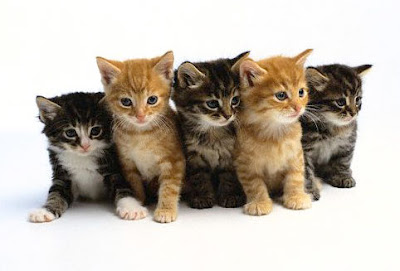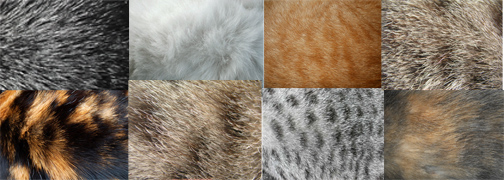Domestic cats are related to wild cats, such as
lions and tigers, and they are able to fend well for themselves. They are
excellent hunters, and their eyes, ears, nose, and whiskers are well adapted
for their natural preference for hunting at night. Cats are affectionate and
respond well to humans. They are domesticated about 4,000 years ago to keep
people company and destroy pests.
There are more than 100 recognized breeds of domestic
cats. They are distinguished mainly by their body shape. People started to
breed cats for their looks between 100 and 150 years ago.
Fur
Cats can be divided into long haired and short haired
breeds. Fur is of various textures. Common coat colors are grey-blue, white,
red, and mixtures of these, such as silver and lilac.
Head shapes
Cat head shapes range from large and round, like
that of the British short-hair, to wedge-shaped, like that of the Siamese. Some
breeds have special characteristics, such as the Scottish fold, which has the
tip of its ears bent forward.
Claws
Cats use their claws to defend themselves and to
climb. At other times, the claws are drawn in, or retracted, for protection.
They are covered by a bony sheath that is an extension of the last bone of each
toe and fit inside pockets in the skin.
 |
| Claws working mechanism |
Senses
Cats can see well in low light and can focus on
small objects a long way away. Their super sensitive hearing picks up sounds
that we cannot hear and can also take in two sounds at once, such as mouse in a
thunderstorm. Their ears are funnel-shaped to draw sounds inside the ear. Whiskers
are sensitive to touch. Cats use them to feel their way in the dark, and to
measure whether spaces are wide enough for them to go through. Sense of taste
is important for distinguishing any food that may be harmful.
A cat’s pupils expand enormously in the dark to let
in as much light as possible. A layer of cells at the back of the eyes, called
the tapetum, reflects light back into the eye
which helps cats see in the dark. Cats rely more on eyesight than smell when
hunting. They have the largest eyes in relation to their size of any animal.
 |
| Cat's eye cycle |
Balance
A cat’s long flexible tail helps it to balance. Cats
will almost always land on their feet, even when falling from a great height. They
have very quick reflexes and can twist and turn their body the right way up in a
fraction of a second.
Grooming
Cats are very clean animals and spend at least an
hour a day grooming, using their tongue as a ”comb”. The tongue has tiny hard spines,
called papillae, on its surface. The licking helps to keep the fur clean and
waterproof, and also spreads the cat’s scent all over its body.
Kittens
Cats have an average of four or five kittens in a
litter. Kittens love to stalk, chase, and pounce on things. This helps to make
them strong, and develops the skills they will need as adults.
 |
| A Litter |







No comments:
Post a Comment